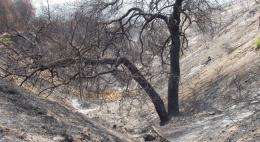Rain, Rain, Go Online

(PhysOrg.com) -- A new webcam at NASA's Jet Propulsion Laboratory is keeping an eye on debris and water flows that could course down nearby wildfire-stripped hillsides during a rainstorm.
The camera, installed by the U.S. Geological Survey, looks over the Arroyo Seco, a usually dry riverbed on the east side of JPL property. The Lab, in addition to the National Weather Service, the U.S. Geological Survey and first responders will be monitoring the images for large pulses of water and debris, which could damage surrounding areas.
The public can also watch the current state of the stream in real-time at ca.water.usgs.gov/webcams/jpl/ . New images appear every five minutes, and users can control the camera for up to three minutes at a time.
The Station fire, as it's known, charred more than 160,000 acres in and around the San Gabriel Mountains and crept to within an eighth of a mile of JPL in late August 2009. Rains this month caused mudslides on slopes burned bare by the fire and damaged homes in areas not far from JPL. Mudslides and debris flows could potentially threaten foothill communities for years to come.
The U.S. Geological Survey approached Eric Fuller, JPL's emergency preparedness administrator, after he attended a meeting with geologists, fire officials, land managers and other stakeholders. The Survey installed the camera in early February, and JPL has provided electrical power and a network line.
"Though we haven't had any damage at JPL, we want to be prepared and we want everyone else to be, as well," Fuller said.
The webcam is part of JPL's ongoing interest in studying the effects of the Station fire. Shortly after the most intense part of the wildfire, Tom Farr, a geologist at JPL, began working with researchers from the California Institute of Technology, the Survey and Arizona State University, Tempe, to study how sediment is moving on scorched hillsides around the Arroyo.
Farr, who has jogged regularly through the area for more than 20 years, now uses the daily runs for field work. His photos show log jams, erosion around guard rails and displaced boulders. He has also noted that in some places streams have flowed into old channels and others have broken off pavement from the roads. He also checks rain rates recorded by the JPL weather station, available at weatherstation.jpl.nasa.gov/ .
"The Arroyo Seco is almost unrecognizable from before the fires," Farr said. "A huge amount of sediment has been deposited and in some places eroded during the last few storms. We'll want to keep watching."
Provided by JPL/NASA



















